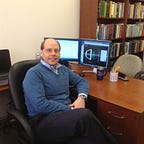Einstein and Special Relativity
What idea made Einstein develop special relativity?
Last time, we continued our look at special relativity and how it is sometimes an afterthought in education, which is a shame because it lays the foundation for so many important ideas to be used later on.
I have been listening to an amazing audio book during my commute. It is called The Information by James Gleick. The book is not new, and although I was aware of it and the author for many years, I only recently had the chance to enjoy the book. I highly recommend it. The book discusses many, many topics including the first attempts at standardizing time. This is something that I already had some insight into, how it related to the railroads, how these innovations and ideas led to a better understanding of weather and other great discoveries of the early twentieth century.
Time was always time, but before there was “fast” travel between cities, time was thought of differently. Time was local because that is what mattered. The “time” in New York or London was for New Yorkers and Londoners and didn’t matter to a Midwestern farmer. A majority of the people in the United States lived in rural environments until roughly 1920. In a rural setting, it matters when the sun rises and sets, when it was highest in the sky, and how long was the day. Parceling it out to a far off clock, or even a close by clock, just didn’t matter much. Neither would the idea of daylight saving. I am reminded of stories about the size of a town being set by the distance you could hear its church bells. The world was very local and few people ever traveled more than a few miles from where they were born.
However, once you had train travel, the telling of time needed to change. Not just for arrivals and departures, but because conductors needed to know when they tracks were available or there would be accidents — and there were accidents. In Great Britain, around 98 percent of train stations had adopted Greenwich Mean Time by 1855. At least in principle. It came a little later in Germany, which required the use of “Berlin time” across the entire empire as of April 1, 1893.
Enter Einstein
Saying that all train stations in a country should use the same time sounds obvious today, but this introduced a new problem — how do you synchronize all those clocks? This is worth thinking about even today. Let’s make it interesting, though. What if I told you to synchronize all the clocks in a city, or a state, or the entire United States? What if you had to do it for satellites in space, the Mars Rovers, and the New Horizons spacecraft (currently a little more than 51 AU from the sun). What if I told you to synchronize those clocks to the nano-second? Right. It’s easy to dismiss the idea of getting all the clocks in Germany to read the same time to within one second, but when you were born in a world of postal letters and horseback travel, this was quite the problem.
Like all good technical problems, people started to think of ways to solve the problem and to patent their solution. You’d do the same. At the time, there were dozens of these kinds of patents floating around the patent offices all around Europe. There were patents floating around places like Bern, where Einstein was working. If he wasn’t directly examining a clock patent, the man at the next desk might be, and the people in the office would talk. These ideas were in the air. But, as we know, Einstein had already spent a great deal of time thinking deeply on the issue of simultaneity. He wondered, would it even be possible, even in principle, to synchronize two clocks? And if so, would two observers agree that they were synchronized?
This very specific problem allowed Einstein to think about a problem that had bothered him for a long time, the question of whether absolute time and absolute space existed at all. Many writers of the time had been writing about such a possibility, but they had done so in very qualitative ways (such musing exist in a series of books by Aaron Bernstein that had long fascinated Einstein) or based on philosophical arguments and ideas (like those put forward by Ernst Mach). However, Einstein wanted a concrete mathematical example, and moreover, he wanted to understand what it meant for the rest of physics.
In November 1915, Einstein wrote a small, popular book on relativity for a general audience (which is now available for free) where he gave an example using a moving train. Next time, we will dive into this thought experiment in great detail and focus on what it meant for physics.
